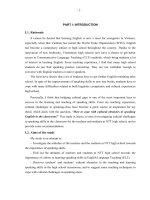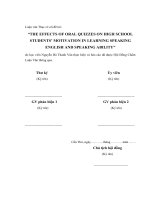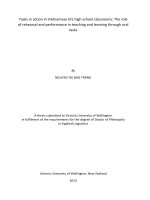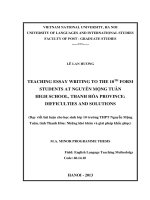unit 16 the wonders of the world page 153 nguyen duc canh high school teacher phi thi hue april 25th 2009 period 43 unit 16 the wonders of the world a period 1 reading i objectives students can compre
Bạn đang xem bản rút gọn của tài liệu. Xem và tải ngay bản đầy đủ của tài liệu tại đây (121.14 KB, 14 trang )
<span class='text_page_counter'>(1)</span><div class='page_container' data-page=1>
<b>April 25</b>
<b>th</b><b><sub> 2009</sub></b>
<b>Period: 43</b>
<b>UNIT 16 : THE WONDERS OF THE WORLD</b>
<b>A. Period 1 : READING</b>
<i><b>I. Objectives :</b></i>
- Students can comprehend the reading passage and do some comprehension tasks
- Students are likely to base on the newwords given in the passage and the contexts of the
sentences and then fill in the words with the suitable meaning and form
- Students are required to read, find out the information to answer the questions about the specific
content
- Students are also able to guess the meanings of the words based on the reading context.
<i><b>II. Skills</b></i><b>:</b> Reading for gist and for specific information
<i><b>III. Method</b></i><b>:</b> Integrated , mainly communicative
<i><b>IV. Lexical Items :</b></i>
- pyramid to rank consist of theories
- construction weight arms bury
<i><b>V.Time required :</b></i>45 minutes
<i><b>VI. Teaching Aids :</b></i>- English textbook 11
- the pictures related to the topic of the reading passage
<i><b>VII. Procedure:</b></i> Teacher :T Students : Ss
<b>Teacher’s Activities</b> <b>Students’ Activities</b>
<b>1.Warm-up : (3 minutes )</b>
- asks Ss to close their books
- hangs the pictures required in the reading
passage , then asks Ss to guess where it is in the
pictures
- gets some Ss to give the answer and confirm
- leads in the topic of the lesson :
- Close the books
- Work in pairs and find out the answer
- Expected answers : the Great Pyramids in Egypt and
Taj Mahal in India.
</div>
<span class='text_page_counter'>(2)</span><div class='page_container' data-page=2>
<i><b>The tilte of the Unit 16 is ‘The wonders of the</b></i>
<i><b>world’ and today we are going to read a</b></i>
<i><b>passage about ‘The Great Pyramid of Giza’.</b></i>
<b>2. Pre- reading : ( 7 minutes) </b>
- tells Ss to look at the pictures again and raises
some questions to relate Ss to the content of the
reading :
Who built them ?
When were they built ?
Why were they built ?
How were they built ?
- asks some to show their ideas and accept all
possible answers
- provides some key newwords and their
explanation to help Ss easier to understand the
reading text.
<b>3. While- reading : ( 22 minutes )</b>
- tells Ss to open their books and guide Ss to the
tasks to comprehend the content of the passage
<i><b>a. Task 1 :</b></i>
- helps Ss to understand the meanings of the
newwords given in the box to prepare for the
next comprehension tasks by different
techniques. Then asks Ss to find their forms
- confirms the answers and quickly asks Ss to
read the sentences silently, based on the context
and the possible forms of the blank words to fill
in the right words
- walks around the class and offers help if
necessary
- asks some to present their answers and
explanation of the answers
- Work in pairs and exchange the ideas
- Some present and others listen
- Answer T’s questions
- listen and take notes
- try to find out the meanings of the words under the
T’s explanation and their forms
- give the answers
- Follow the T’s guidance
- Work individually and then exchange the answers in
pairs
- others listen and correct if necessary
<i><b>- </b></i>
</div>
<span class='text_page_counter'>(3)</span><div class='page_container' data-page=3>
- gives comments on the answers
<i><b>b. Task 2</b></i>
- instructs Ss to seek the information in the
passage for the questions
- tells Ss to works in pairs, make questions and
answer after finding the right information .
- walks around the class and offers suggestions
when necessary
- gets some pairs to express their ideas and write
on the board.
- asks others to confirm and show the correct
answers
<i><b>c. Task 3 :</b></i>
- gets Ss to scan the text and say what the given
words in Task 3 refer to
- guides Ss to read the contexts around the words
to estimate what they refer to
- tells some Ss at random to give the answer as
<i>1.tomb 2.wonder 3. ramp </i>
<i>4.champer 5. mysterious 6. spiral</i>
- locate the necessary information
- practise in pairs
- some present and others listen and correct
- correct their own answers
<b>- Suggested answers :</b>
<i>1. It is situated on the west bank of the River Nile and</i>
<i>was built around the year 2560 B.C</i>
<i>2. It was about 147 metres high on a base of 230</i>
<i>metres square </i>
<i>3. The purpose of this huge stone pyramid was to</i>
<i>serve as a tomb when the Egyptian Pharaoh Khufu</i>
<i>died and to protect the burial chamber from the</i>
<i>weather and from theives who might try to steal the</i>
<i>treasures and belongings there.</i>
<i>4. It is thought that ancient Egyptians used straight</i>
<i>or spiral ramps or huge weight arms to lift and place</i>
<i>the blocks of stone.</i>
<i>5. The boat is believed to have been used to carry the</i>
<i>body of Khufu in his last journey on earth before</i>
<i>being buried inside the pyramid</i>
- look through the reading passage again and find out
the answers
<b>- Expected answer :</b>
</div>
<span class='text_page_counter'>(4)</span><div class='page_container' data-page=4>
well as the explanation of the answer and others
give comments
<b>4. Post – reading : ( 10 minutes )</b>
- haves Ss discuss the question ‘Which of the
wonders of the world do you prefer and why ?’
in groups
- make suggestions if necessary
- requires Ss to discuss in groups based on the
information given in the reading passage and
encourages Ss to find other benefits
- gives marks to good presentation
<b>5. Homework : (3 minutes )</b>
- asks Ss to rewrite the ideas of their group give
in the post reading in a short paragraph
- offers the newwords or suggested information
if necessary
<i> It ( line 9 ) refers to the Great Pyramid </i>
<i> Each ( line 12 ) refers to the block of stone </i>
- discuss in groups and have a group leader to take
note all the opinions of the group
- group leaders take turns making presentation
- write down the homework
<b>April 26</b>
<b><sub> 2009</sub></b>
<b>th</b><b>Period :44</b>
<b>B . Period 2 : SPEAKING</b>
<i><b>I. Objectives :</b></i>
- Students are able to practise their skills especially speaking skill.
- Students can tell others about some facts and opinions
</div>
<span class='text_page_counter'>(5)</span><div class='page_container' data-page=5>
<i><b>II. Skills :</b></i>
Fluency in expressing facts, opinions and prediction
<i><b>III. Method :</b></i> Integrated , mainly communicative
<i><b>IV. Lexical Items :</b></i>
revision of newwords given in the reading text
<i><b>V. Time required :</b></i> 45 minutes
<i><b>VI. Teaching Aids :</b></i> - English textbook 11
- the picture of the Great Pyramid of Giza
<i><b>VII. Procedure:</b></i> Teacher :T Students : Ss
<b>Teacher’s Activities</b> <b>Students’ Activities</b>
<b>1. Warm-up :(5 minutes)</b>
- shows the picture of the Great Pyramid of
Giza and asks Ss to recall the main information
about it
- asks some to present their ideas
- leads in the lesson :
<i><b>Today we are going to practise speaking</b></i>
<i><b>about the Great Pyramid of Giza you have</b></i>
<i><b>learned and other wonders of the world</b></i>
<b>II. Pre- speaking (13minutes)</b>
<i><b>Task 1:</b></i>
- lets Ss to open their textbooks
- tells Ss classify the sentences in Task 1 into
facts or opinions and then tick in the suitable
column
- checks Ss’ work
<i><b>Task 2 :</b></i>
- tells Ss to read aloud the facts and opinions of
- look at the picture and try to remember the
information about the Great Pyramid of Giza
- listen attentively
- open the textbook
- listen attentively and follow T’s guidance
- work individually and then in pairs to exchange
the answers
<i><b>- Expected answer :</b></i>
</div>
<span class='text_page_counter'>(6)</span><div class='page_container' data-page=6>
the Great Pyramid given in Task 1
- corrects Ss’ answers with other students
<b>III. While – speaking (20 minutes)</b>
<i><b>Task 3 :</b></i>
- asks Ss to work in groups discussing the
following questions :
Who built the Great Pyramid of Giza ?
How long did it take to build it ?
Where did the builders find the stones ?
How did they transport them ?
How could they build the Pyramid so high?
- suggests Ss using the useful language given in
Task 3 and explains the strucutures
- walks around the class and provides help
when Ss have difficulty in their expression.
- tells some group leaders to make presentation
in front of the class
- comments and give marks to good presenters
<b>IV. Post – speaking :( 5 minutes )</b>
- asks Ss to give short information about other
wonders of the world they know
- gives marks to good presenters
<b>V. Homework : (2 minutes)</b>
- tells Ss to write down the information about
the wonders of the world they discuss in
Post-speaking in short paragraph
- correct their own answers
- listen to T’s instructions carefully and discuss in
groups
- group leaders take turns showing their ideas.
- discuss in groups
- make reports
- take note the homework
<b>April 28</b>
<b>th</b><b><sub> 2009</sub></b>
</div>
<span class='text_page_counter'>(7)</span><div class='page_container' data-page=7>
<b>C. Period 3 : LISTENING</b>
<i><b>I. Objectives :</b></i>
- Students are motivated to practise their skills especially listening skill
- Students can listen and fill in the missing information
- Students are able to take notes the main information and answer the questions
<i><b> II. Skills :</b></i>
Listening for gist and for specific information
<i><b>III. Lexical Items :</b></i>
man-made wonder magnificence and significance world heritage UNESCO
Ming Dynasty ancient stone roadway Beijing
<i><b>V.Time required :</b></i> 45 minutes
<i><b>VI. Teaching aids :</b></i> - English textbook 11
- a casettee and a tape recorder
<i><b>VII. Procedure:</b></i> Teacher : T Students : Ss
<b>Teacher’s Activities</b> <b>Students’ Activities</b>
<b>1. Warm-up : (5 minutes)</b>
- asks Ss to close their books
- shows the picture of the Great Wall and ask
Ss guess where it is in the picture
- leads in the lesson :
<i><b>Today we are going to listen to a passage</b></i>
<i><b>about the Great Wall of China </b></i>
<b>2. Pre- listening : (7 minutes)</b>
- asks Ss to answer some questions to relate
them to the topic of the listening passage :
Where is the Great Wall located in
China?
When was it built ?
Is it one of the greatest man-made
wonders in the world ?
-close their books
- look at the picture and guess the place in the picture
- keep in mind the main topic of the listening text
- answer T’s questions
</div>
<span class='text_page_counter'>(8)</span><div class='page_container' data-page=8>
- provides the key newwords related to the
main ideas of the listening and give their
meanings as quickly as possible.
- tells Ss to read newwords in chorus and
individually and memorise them
<b>3. While – listening : (20 minutes)</b>
<b>a. Task 1 :</b>
- instructs Ss to do Task 1
- asks Ss to read through the table of
information
- lets Ss listen to the tape the first time
- checks whether Ss have the answers or not
- gets Ss to take the second listening
- haves Ss work individually and then in pairs
to exchange the answers
- Ss’ answers may vary but T accepts all the
possible answers and quickly lets Ss have the
third listening to check Ss’ answers and point
out the information for the correct answers
<b>b. Task 2 : </b>
- gives instructions : listen to the tape again,
try to take notes the brief information for the
questions, then lets them have time to make full
answers
- plays the tape again from the beginning to the
end and asks Ss to locate the information for
the answers
- read in chorus and individually
- read through the blank information
- listen and try to find the answers
- listen again , check their own answers and exchange
the answers with other students
- listen the third time and seek the information for the
right answers , check with T and correct their own
answers
<b>- Suggested answers :</b>
o <i>Attraction of the wall : 1. the moon 2.</i>
<i>1987 </i>
o <i>Construction of the wall :</i>
<i>3. the Ming Dynasty 4. 200 5. 200 B.C </i>
o <i>Special features of the wall :</i>
<i> 6. 6000 km 7. 11 metres 8. stones </i>
- understand the task
</div>
<span class='text_page_counter'>(9)</span><div class='page_container' data-page=9>
- gets Ss to listen again and sometimes pauses
at listening passage that shows the answers
- lets them make full answers after taking notes
- checks whether Ss have any answers or not
- lets Ss exchange the answers in pairs
- accepts all the possible answers and tell some
to ask and answer and then write the answers
on the blackboard
- For the third listening, T pauses the tape from
time to time while listening in order to help Ss
get the correct answers
<b>4. Post – listening : (10 minutes)</b>
- asks Ss to work in pairs and tell their partner
why the Great Wall is considered one of the
greatest wonders in the world and how it was
built
- walks around the class and provides assitance
if necessary.
- asks some to present their opinions and gives
marks to the good ones.
<b>5. Homework : (3 minutes)</b>
- asks Ss to write a paragraph about the Great
Wall of China
- listen again , try to take notes short words or
phrases for the answers
- work individually and then in pairs
- listen the last time and check the answers with T
<b>- Suggested answers :</b>
<i>1. The ancient Chinese started to build the Great</i>
<i>Wall in 1368.</i>
<i>2. The wall covers five provinces. </i>
<i>3. Because it can be seen from the moon.</i>
<i>4. The part in the northwest of Beijing is the best</i>
<i>choice for visit because it is still in its original state </i>
- base on the information given in the above tasks to
talk with the partner about the Great Wall.
- others listen
- write down in their notebooks
</div>
<span class='text_page_counter'>(10)</span><div class='page_container' data-page=10>
<b>Period :46</b>
<b>D. Period 4 : WRITING</b>
<i><b>I. Objectives :</b></i>
- Students are able to improve their skill especially writing skill
- Students can understand and write general information about the wonders in Vietnam
- Students are likely to write a short report on the visit to a wonder in Vietnam
<i><b>II. Skills :</b></i>
Writing a report on the visit to a wonder
<i><b>III. Lexical Items :</b></i>
brief tour architecture consist of be located in honour of sandstone statue
Buddha’s throne illustrate to last be dedicated to memorable
<i><b>V.Time required :</b></i> 45 minutes
<i><b>VI. Teaching Aids :</b></i> - English textbook 11
<i><b>VII. Procedure:</b></i> Teacher :T Students : Ss
<b>Teacher’s Activities</b> <b>Students’ Activities</b>
<b>1. Warm – up : (3 minutes)</b>
- tells Ss to close the textbook
- shows the photo of the Ponagar Cham Towers
in Nha Trang and tells Ss to give their knowlege
of the wonder
- leads in the topic of the writing :
<i><b>Today we are going to write a report on the visit</b></i>
<i><b>to Ponagar Cham Tower . </b></i>
<b>2. Pre – writing : (10 minutes)</b>
- provides newwords for the report to make sure
that Ss can understand the suggested information
carefully.
- asks Ss to discuss the information given in the
suggestions to make them understand the
- close the textbook
- look at the photo and give information about
the wonder in the photo
- listen carefully
- take notes the newwords
</div>
<span class='text_page_counter'>(11)</span><div class='page_container' data-page=11>
information they are going to write in the report
<b>3. While – writing : (20 minutes)</b>
- tells Ss individually to write a short report on
the visit to Cham tower using the given
suggestions
- walks around the class and provides
suggestions when Ss need help
- lets Ss to exchange their writings and correct
mistakes
- asks some to write their report on the board
- checks with others, then give comments and
marks
<b>4. Post – writing :(10 minutes)</b>
- tells Ss to talk about the Cham tower and
memorable feelings of their visit to the wonder
of Vietnam
- gives marks to the good presenters
<b> 5. Homework : (2 minutes)</b>
Write a short report on the visit to the wonder
you have ever travelled
- write individually
- correct the partner’s writing
- correct their own writings
- others listen
- write down the homework
<b>April 30</b>
<b>th</b><b><sub> 2009 </sub></b>
<b>Period : 47</b>
<b>E. Period 5 : LANGUAGE FOCUS</b>
<i><b>I. Objectives :</b></i>
- Students are able to practise the pronunciation of double consonants ‘ft’ , ‘vd’ , ‘fs’ and ‘vz’ in
single words and utterances
- Students can use ‘It is said that...’ and ‘People say that...’ in suitable utterances or
writing
<i><b>II. Skills :</b></i>
</div>
<span class='text_page_counter'>(12)</span><div class='page_container' data-page=12>
<i><b>III. Lexical Items :</b></i>
<i><b>V.Time required :</b></i> 45 minutes
<i><b>VI. Teaching aids :</b></i> - English textbook 11
- handouts of exercises
<i><b>VII. Procedure:</b></i> Teacher :T Students : Ss
<b>Teacher’s Activities</b> <b>Students’ Activities</b>
<b>1. Pronunciation (15 minutes)</b>
<b>a. Task 1 ( Listen and repeat ) :</b>
- reads aloud the double consonants and asks
Ss to focus on the differences among them
- lets Ss listen again and repeat each word in
<i>Listen and repeat </i>
- asks some Ss to read aloud and corrects their
mistakes if necessary
<b>b.Task 2 ( Practise reading these sentences ):</b>
- asks Ss to listen to the tape and practise
pronouncing after the tape, concentrate on the
sentences stress.
- walks around and provides help when Ss need
- asks some Ss to read aloud and other to
correct their friends’ mistakes, then confirms
again if necessary
<b>3. Grammar : ( 25 minutes)</b>
<i><b>a</b><b>.</b><b>Present the form :</b></i>
- gives some examples :
Eg1 : + It is thought that the boss will resign
+ In the old days it was said that illness
were caused by evil spirits
+ The boss is thought to resign
+ In the old days illness was said to
have been caused by evil spirits
- listen to T carefully
- listen and repeat after T
- first practise pronouncing with T and then drill
individually
- others listen and correct their own mistakes
- practise in chorus after the tape, then individually
- others listen and correct their friends’ mistakes
and their own ones.
</div>
<span class='text_page_counter'>(13)</span><div class='page_container' data-page=13>
- tells Ss to show the forms through the
examples
- confirms the answers and present the forms :
<i>It be said / thought / believed / expected /</i>
<i> known that clause ( S-V )</i>
<i>Subject + passive verb ( be said / thought....)</i>
<i>+ to V ( simple present or simple future) / to</i>
<i>have + PII ( simple past ) / to have been + PII</i>
<i>( passive of simple past ).</i>
<i><b>b</b><b>. Exercises</b></i>
<b>Exercise 1</b>
- explains the requirement of Exercise 1
- haves Ss do Exercise 1 individually and
discuss the answers with their partners
- asks some Ss to read out the answers and
write on the blackboard.
- checks with others and confirms the correct
answers again.
<b>Exercise 2</b>
- explains the requirement of Exercise 2
- listen and write down in the notebooks
- work individually and then in pairs
- others check their classmates’ answers
- correct their own answers
<b>- Suggested answers : </b>
<i>1. Many people are said to be homeless after the</i>
<i>floods </i>
<i>2. The prison is thought to have escaped by</i>
<i>climbing over the wall. </i>
<i>3. He is believed to have driven through the</i>
<i>town at 90 km an hour </i>
<i>4. Two people are reported to have been</i>
<i>seriously injured in the accident .</i>
<i>5. Three men are said to have been arrested</i>
<i>after the explosion .</i>
</div>
<span class='text_page_counter'>(14)</span><div class='page_container' data-page=14>
- haves Ss do Exercise 2 individually and
discuss the answers with their partners
- asks some Ss to read out the answers and
write on the blackboard.
- checks with others and confirms the correct
answers again.
<b>4. Homework : (5 minutes)</b>
- provides handouts of extra exercises
- explains newwords or requirement if
necessary
- work individually and then in pairs
- others check their classmates’ answers
- correct their own answers
<b>- Suggested answers : </b>
<i>1. He is thought to be very clever </i>
<i>2. The wanted man is believed to be living in</i>
<i>New York l. </i>
<i>3. He is known to be very rich </i>
<i>4. The film is supposed to be very good</i>
<i>5. Many people are thought to have been killed</i>
<i>in the accident.</i>
<i>6. About a million puppies are thought to be</i>
<i>born each year .</i>
<i>7. The factories are said to be much worse .</i>
<i>8. Those dogs are said to be dangerous.</i>
</div>
<!--links-->









